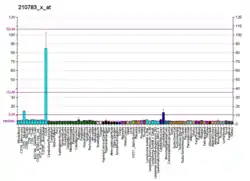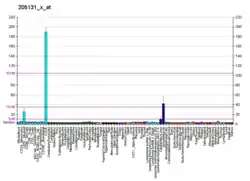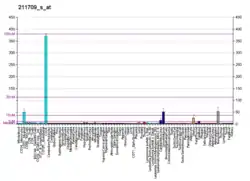CLEC11A
C-type lectin domain family 11 member A is a protein that in humans is encoded by the CLEC11A gene.[4][5][6]
| CLEC11A | |||||||||||||||||||||||||
|---|---|---|---|---|---|---|---|---|---|---|---|---|---|---|---|---|---|---|---|---|---|---|---|---|---|
| Identifiers | |||||||||||||||||||||||||
| Aliases | CLEC11A, CLECSF3, LSLCL, P47, SCGF, C-type lectin domain family 11 member A, C-type lectin domain containing 11A | ||||||||||||||||||||||||
| External IDs | OMIM: 604713 MGI: 1298219 HomoloGene: 2236 GeneCards: CLEC11A | ||||||||||||||||||||||||
| |||||||||||||||||||||||||
| |||||||||||||||||||||||||
| |||||||||||||||||||||||||
| Orthologs | |||||||||||||||||||||||||
| Species | Human | Mouse | |||||||||||||||||||||||
| Entrez | |||||||||||||||||||||||||
| Ensembl | |||||||||||||||||||||||||
| UniProt | |||||||||||||||||||||||||
| RefSeq (mRNA) | |||||||||||||||||||||||||
| RefSeq (protein) | |||||||||||||||||||||||||
| Location (UCSC) | Chr 19: 50.72 – 50.73 Mb | n/a | |||||||||||||||||||||||
| PubMed search | [2] | [3] | |||||||||||||||||||||||
| Wikidata | |||||||||||||||||||||||||
| |||||||||||||||||||||||||
Function
This gene encodes a member of the C-type lectin superfamily. The encoded protein is a secreted sulfated glycoprotein and functions as a growth factor for primitive hematopoietic progenitor cells. An alternative splice variant has been described but its biological nature has not been determined.[6]
References
- GRCh38: Ensembl release 89: ENSG00000105472 - Ensembl, May 2017
- "Human PubMed Reference:". National Center for Biotechnology Information, U.S. National Library of Medicine.
- "Mouse PubMed Reference:". National Center for Biotechnology Information, U.S. National Library of Medicine.
- Hiraoka A, Sugimura A, Seki T, Nagasawa T, Ohta N, Shimonishi M, Hagiya M, Shimizu S (July 1997). "Cloning, expression, and characterization of a cDNA encoding a novel human growth factor for primitive hematopoietic progenitor cells". Proceedings of the National Academy of Sciences of the United States of America. 94 (14): 7577–82. Bibcode:1997PNAS...94.7577H. doi:10.1073/pnas.94.14.7577. PMC 23864. PMID 9207134.
- Bannwarth S, Giordanengo V, Lesimple J, Lefebvre JC (January 1998). "Molecular cloning of a new secreted sulfated mucin-like protein with a C-type lectin domain that is expressed in lymphoblastic cells". The Journal of Biological Chemistry. 273 (4): 1911–6. doi:10.1074/jbc.273.4.1911. PMID 9442024.
- "Entrez Gene: CLEC11A C-type lectin domain family 11, member A".
Further reading
- Hiraoka A, Ohkubo T, Fukuda M (October 1987). "Production of human hematopoietic survival and growth factor by a myeloid leukemia cell line (KPB-M15) and placenta as detected by a monoclonal antibody". Cancer Research. 47 (19): 5025–30. PMID 3304620.
- Mio H, Kagami N, Yokokawa S, Kawai H, Nakagawa S, Takeuchi K, Sekine S, Hiraoka A (August 1998). "Isolation and characterization of a cDNA for human mouse, and rat full-length stem cell growth factor, a new member of C-type lectin superfamily". Biochemical and Biophysical Research Communications. 249 (1): 124–30. doi:10.1006/bbrc.1998.9073. PMID 9705843.
- Bannwarth S, Giordanengo V, Grosgeorge J, Turc-Carel C, Lefebvre JC (April 1999). "Cloning, mapping, and genomic organization of the LSLCL gene, encoding a new lymphocytic secreted mucin-like protein with a C-type lectin domain: A new model of exon shuffling". Genomics. 57 (2): 316–7. doi:10.1006/geno.1999.5762. PMID 10198175.
- Gehling UM, Ergün S, Schumacher U, Wagener C, Pantel K, Otte M, Schuch G, Schafhausen P, Mende T, Kilic N, Kluge K, Schäfer B, Hossfeld DK, Fiedler W (May 2000). "In vitro differentiation of endothelial cells from AC133-positive progenitor cells". Blood. 95 (10): 3106–12. doi:10.1182/blood.V95.10.3106. PMID 10807776.
- Perrin C, Bayle J, Bannwarth S, Michiels JF, Heudier P, Lefebvre JC, Giordanengo V (December 2001). "Expression of LSLCL, a new C-type lectin, is closely restricted, in bone marrow, to immature neutrophils". Comptes Rendus de l'Académie des Sciences, Série III. 324 (12): 1125–32. doi:10.1016/s0764-4469(01)01392-0. PMID 11803813.
- Hiraoka A, Yano Ki K, Kagami N, Takeshige K, Mio H, Anazawa H, Sugimoto S (2002). "Stem cell growth factor: in situ hybridization analysis on the gene expression, molecular characterization and in vitro proliferative activity of a recombinant preparation on primitive hematopoietic progenitor cells". The Hematology Journal. 2 (5): 307–15. doi:10.1038/sj.thj.6200118. PMID 11920266.
- Ito C, Sato H, Ando K, Watanabe S, Yoshiba F, Kishi K, Furuya A, Shitara K, Sugimoto S, Kohno H, Hiraoka A, Hotta T (August 2003). "Serum stem cell growth factor for monitoring hematopoietic recovery following stem cell transplantation". Bone Marrow Transplantation. 32 (4): 391–8. doi:10.1038/sj.bmt.1704152. PMID 12900775.
- Lee E, Min HK, Oskeritzian CA, Kambe N, Schwartz LB, Wook Chang H (November 2003). "Recombinant human (rh) stem cell factor and rhIL-4 stimulate differentiation and proliferation of CD3+ cells from umbilical cord blood and CD3+ cells enhance FcepsilonR1 expression on fetal liver-derived mast cells in the presence of rhIL-4". Cellular Immunology. 226 (1): 30–6. doi:10.1016/j.cellimm.2003.11.001. PMID 14746805.
- Hollenbeck ST, Sakakibara K, Faries PL, Workhu B, Liu B, Kent KC (August 2004). "Stem cell factor and c-kit are expressed by and may affect vascular SMCs through an autocrine pathway". The Journal of Surgical Research. 120 (2): 288–94. doi:10.1016/j.jss.2004.01.005. PMID 15234225.
External links
- Human CLEC11A genome location and CLEC11A gene details page in the UCSC Genome Browser.
This article is issued from Wikipedia. The text is licensed under Creative Commons - Attribution - Sharealike. Additional terms may apply for the media files.




